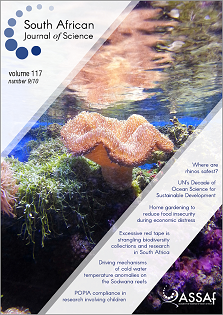Meta-analysis of factors affecting prevalence estimates of HIV-associated neurocognitive disorder in sub-Saharan Africa
DOI:
https://doi.org/10.17159/sajs.2021/8575Keywords:
HIV infection, neurocognitive disorder, prevalence, sub-Saharan Africa, study characteristicsAbstract
Successful treatment of HIV with anti-retroviral therapy (ART) is resulting in more people living with HIV-associated neurocognitive disorder (HAND). In sub-Saharan Africa, this calls for strategic planning and judicious allocation of scarce resources, which requires an accurate estimate of the prevalence of HAND. Estimates of the prevalence of HAND in sub-Saharan Africa vary greatly, between 18.8% and 88.3%. This variability may be explained by factors such as different diagnostic approach, neuromedical examination, ART status, sampling method, substance abuse, assessors’ qualification, depression and outcome measure. Different methods of diagnosing HAND, different outcome measures and non-random sampling techniques make it almost impossible to accurately estimate the prevalence of HAND in sub- Saharan Africa, often resulting in overestimation of the burden of disease. Consumers of health research should consider certain study characteristics and exercise appropriate caution when interpreting burden of disease in sub-Saharan Africa, especially when pursuing policy shift. Underestimating the prevalence of HAND will certainly affect the capacity and speed of containment, while overestimating will draw unnecessary attention and result in the misallocation of scarce resources.
Significance:
- The high prevalence of HAND in sub-Saharan Africa as estimated in this review calls for further research on the impact of HAND on activities of daily living and putative therapeutic modalities.
- We highlight which study characteristics should be critically checked when using prevalence estimates for the purpose of health policy and distribution of scarce resources in sub-Saharan Africa.
- By favouring certain factors, this review will guide HIV health researchers in which techniques should be used to estimate the burden of HAND. These factors may also apply to estimating the burden of other diseases in sub-Saharan Africa.
Published
Issue
Section
License

This work is licensed under a Creative Commons Attribution 4.0 International License.

All articles are published under a Creative Commons Attribution 4.0 International Licence
Copyright is retained by the authors. Readers are welcome to reproduce, share and adapt the content without permission provided the source is attributed.
Disclaimer: The publisher and editors accept no responsibility for statements made by the authors
How to Cite
- Abstract 770
- PDF 664
- EPUB 168
- XML 160
Funding data
-
University of Pretoria
Grant numbers 1338












.png)